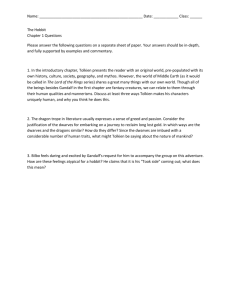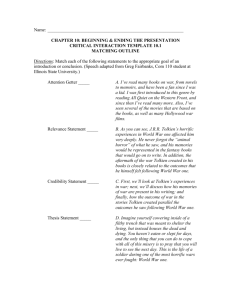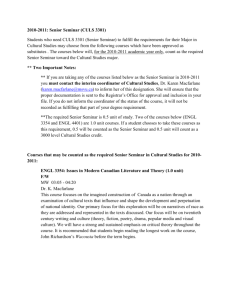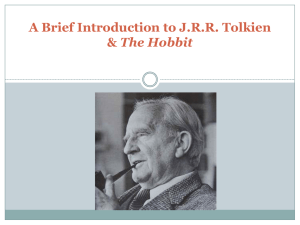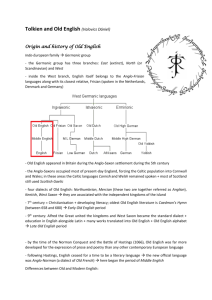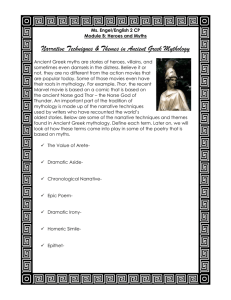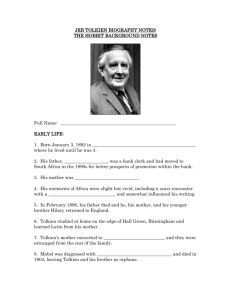Influences_on_Lord_of_The_Rings
advertisement
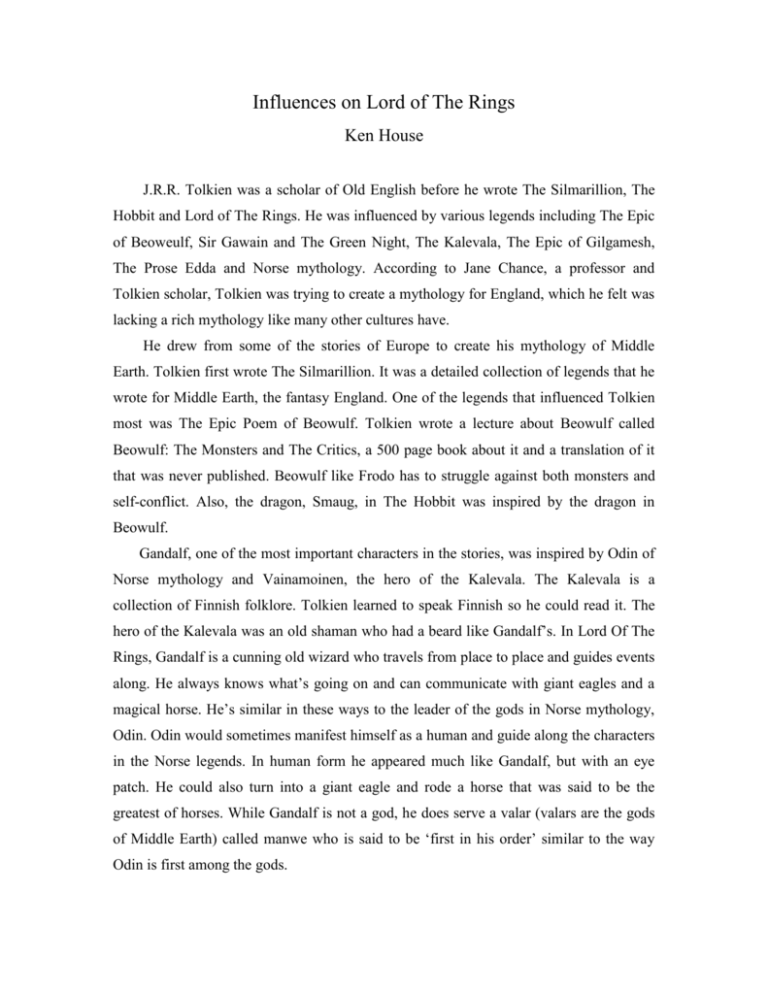
Influences on Lord of The Rings Ken House J.R.R. Tolkien was a scholar of Old English before he wrote The Silmarillion, The Hobbit and Lord of The Rings. He was influenced by various legends including The Epic of Beoweulf, Sir Gawain and The Green Night, The Kalevala, The Epic of Gilgamesh, The Prose Edda and Norse mythology. According to Jane Chance, a professor and Tolkien scholar, Tolkien was trying to create a mythology for England, which he felt was lacking a rich mythology like many other cultures have. He drew from some of the stories of Europe to create his mythology of Middle Earth. Tolkien first wrote The Silmarillion. It was a detailed collection of legends that he wrote for Middle Earth, the fantasy England. One of the legends that influenced Tolkien most was The Epic Poem of Beowulf. Tolkien wrote a lecture about Beowulf called Beowulf: The Monsters and The Critics, a 500 page book about it and a translation of it that was never published. Beowulf like Frodo has to struggle against both monsters and self-conflict. Also, the dragon, Smaug, in The Hobbit was inspired by the dragon in Beowulf. Gandalf, one of the most important characters in the stories, was inspired by Odin of Norse mythology and Vainamoinen, the hero of the Kalevala. The Kalevala is a collection of Finnish folklore. Tolkien learned to speak Finnish so he could read it. The hero of the Kalevala was an old shaman who had a beard like Gandalf’s. In Lord Of The Rings, Gandalf is a cunning old wizard who travels from place to place and guides events along. He always knows what’s going on and can communicate with giant eagles and a magical horse. He’s similar in these ways to the leader of the gods in Norse mythology, Odin. Odin would sometimes manifest himself as a human and guide along the characters in the Norse legends. In human form he appeared much like Gandalf, but with an eye patch. He could also turn into a giant eagle and rode a horse that was said to be the greatest of horses. While Gandalf is not a god, he does serve a valar (valars are the gods of Middle Earth) called manwe who is said to be ‘first in his order’ similar to the way Odin is first among the gods. Tolkien was also influenced by the Prose Edda, an Icelandic story written around 1200 AD and inspired by Norse mythology. The names of most of the dwarves in The Hobbit are the same as the names of a group of dwarves in the Prose Edda. One of the dwarves was also named Gandalf. There are more references to the Prose Edda in the Silmarillion. At one point, he writes that whoever tastes the heart of dragon will know the languages of all gods, men, birds and beasts and catch whispers of the valar such as never had he heard before. In the Prose Edda, the hero eats the heart of the dragon Fafnir and gains the ability to speak to birds. In the third book of Lord of The Rings, Samwise saves Frodo by fighting the spider queen, Shelob in a dark underground tunnel. This is likely a reference to the epic of Gilgamesh in which Gilgamesh has to kill scorpion men and go through a long dark tunnel. The character Galadriel also relates to the character Siduri in Gilgamesh and Samwise to Enki. The title of the third book in the Lord Of The Rings, the return of the kings is a reference to the legend of King Arthur, who was supposed to return in the future. Aragorn, the rightful king is related to King Arthur. Tolkien was also very interested in languages. He spoke many languages including English, French, German, Latin, Old English, Finnish, Welsh and Old Norse. He created several of his own languages for The Silmarillion and Lord of The Rings. These include entish, the language spoken by tree men, dwarvish, black speech and two kinds of elvish, Quenya and Sindarin. These new languages were based on some of the old languages that Tolkien had studied. Tolkien was also concerned with the disappearance of cultures and languages in the 20th century. His concerns were echoed in his books. On Middle Earth, the hobbits, elves, dwarves and ents were all becoming scarce in number. Forests had been cut down by villains like the treacherous wizard, Saruman and the dwarven tunnels were inhabited by unappreciative orcs. Tolkien liked to feel like he was part of a long line of storytellers adapting and passing on the myths. He wanted to be a part of creating a rich mythology for England. He often would go into a great deal of detail on matters that were not important to the plot, such as the family trees of hobbits or the history behind a town, not just because it made the world seem more real but because he enjoyed it.
